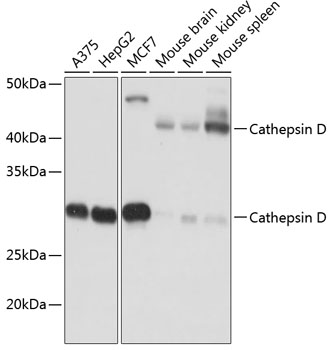Cell Biology Antibodies 17
Anti-Cathepsin D Antibody (CAB19680)
- SKU:
- CAB19680
- Product Type:
- Antibody
- Reactivity:
- Human
- Reactivity:
- Mouse
- Reactivity:
- Rat
- Host Species:
- Rabbit
- Isotype:
- IgG
- Research Area:
- Cell Biology
Description
| Antibody Name: | Anti-Cathepsin D Antibody |
| Antibody SKU: | CAB19680 |
| Antibody Size: | 20uL, 50uL, 100uL |
| Application: | WB IHC |
| Reactivity: | Human, Mouse, Rat |
| Host Species: | Rabbit |
| Immunogen: | A synthesized peptide derived from human Cathepsin D. |
| Application: | WB IHC |
| Recommended Dilution: | WB 1:500 - 1:2000 IHC 1:50 - 1:200 |
| Reactivity: | Human, Mouse, Rat |
| Positive Samples: | A375, HepG2, MCF7, Mouse brain, Mouse kidney, Mouse spleen |
| Immunogen: | A synthesized peptide derived from human Cathepsin D. |
| Purification Method: | Affinity purification |
| Storage Buffer: | Store at -20°C. Avoid freeze / thaw cycles. Buffer: PBS with 0.02% sodium azide, 0.05% BSA, 50% glycerol, pH7.3. |
| Isotype: | IgG |
| Sequence: | Email for sequence |
| Gene ID: | 1509 |
| Uniprot: | P07339 |
| Cellular Location: | |
| Calculated MW: | 46kDa/28kDa |
| Observed MW: | 28KDa/44KDa |
| Synonyms: | CLN10, CPSD, HEL-S-130P, Cathepsin D, CTSD |
| Background: | This gene encodes a member of the A1 family of peptidases. The encoded preproprotein is proteolytically processed to generate multiple protein products. These products include the cathepsin D light and heavy chains, which heterodimerize to form the mature enzyme. This enzyme exhibits pepsin-like activity and plays a role in protein turnover and in the proteolytic activation of hormones and growth factors. Mutations in this gene play a causal role in neuronal ceroid lipofuscinosis-10 and may be involved in the pathogenesis of several other diseases, including breast cancer and possibly Alzheimer's disease. [provided by RefSeq, Nov 2015] |
| UniProt Protein Function: | CTSD: Acid protease active in intracellular protein breakdown. Involved in the pathogenesis of several diseases such as breast cancer and possibly Alzheimer disease. Consists of a light chain and a heavy chain. Belongs to the peptidase A1 family. |
| UniProt Protein Details: | Protein type:Autophagy; Motility/polarity/chemotaxis; Protease; EC 3.4.23.5 Chromosomal Location of Human Ortholog: 11p15.5 Cellular Component: extracellular matrix; extracellular space; lysosomal lumen; lysosome; melanosome; extracellular region Molecular Function:protein binding; aspartic-type endopeptidase activity Biological Process: collagen catabolic process; extracellular matrix disassembly; extracellular matrix organization and biogenesis; antigen processing and presentation of exogenous peptide antigen via MHC class II; proteolysis Disease: Ceroid Lipofuscinosis, Neuronal, 10 |
| NCBI Summary: | This gene encodes a lysosomal aspartyl protease composed of a dimer of disulfide-linked heavy and light chains, both produced from a single protein precursor. This proteinase, which is a member of the peptidase C1 family, has a specificity similar to but narrower than that of pepsin A. Transcription of this gene is initiated from several sites, including one which is a start site for an estrogen-regulated transcript. Mutations in this gene are involved in the pathogenesis of several diseases, including breast cancer and possibly Alzheimer disease. [provided by RefSeq, Jul 2008] |
| UniProt Code: | P07339 |
| NCBI GenInfo Identifier: | 115717 |
| NCBI Gene ID: | 1509 |
| NCBI Accession: | P07339.1 |
| UniProt Secondary Accession: | P07339,Q6IB57, |
| UniProt Related Accession: | P07339 |
| Molecular Weight: | 44,552 Da |
| NCBI Full Name: | Cathepsin D |
| NCBI Synonym Full Names: | cathepsin D |
| NCBI Official Symbol: | CTSD |
| NCBI Official Synonym Symbols: | CPSD; CLN10; HEL-S-130P |
| NCBI Protein Information: | cathepsin D; lysosomal aspartyl protease; lysosomal aspartyl peptidase; ceroid-lipofuscinosis, neuronal 10; epididymis secretory sperm binding protein Li 130P |
| UniProt Protein Name: | Cathepsin D |
| Protein Family: | Cathepsin |
| UniProt Gene Name: | CTSD |
| UniProt Entry Name: | CATD_HUMAN |







